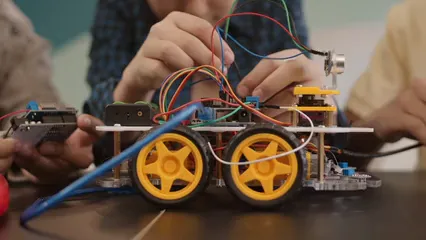Introduction
In the world of engineering, where precision meets unpredictability, probability and statistics serve as the compass guiding us through the fog of uncertainty. Whether you’re designing a bridge that will withstand the test of time or analyzing data to improve a manufacturing process, these mathematical tools are indispensable. This article will unravel the mysteries of probability and statistics specifically tailored for engineers, making complex concepts accessible and relevant. So, buckle up as we embark on a journey that transforms abstract numbers into practical applications, revealing how statistics can be the engineer’s best friend.
Picture this: you’re at a construction site, and the weather forecast predicts a 70% chance of rain. Should you go ahead and pour the concrete? Here, probability steps in as your trusty sidekick, helping you assess the risks. In engineering, every decision is tinged with uncertainty. Probability helps quantify that uncertainty, enabling engineers to make informed choices.
Statistics, on the other hand, is like the detective of the engineering world. It analyzes data collected from experiments, surveys, and real-world observations. With statistics, engineers can identify trends, make predictions, and validate models. It’s not just about crunching numbers; it’s about making sense of them.
For engineers, understanding probability and statistics is vital. These disciplines empower professionals to conduct experiments, test hypotheses, and develop reliable systems. From quality control in manufacturing to risk assessment in construction projects, the applications are vast and varied.
But let’s not kid ourselves—these subjects can be daunting. Many engineers shy away from the math, fearing they lack the skills to grasp these concepts. Fear not! This guide aims to break down the complexities of probability and statistics, making them approachable and, dare we say, fun!
We will cover foundational concepts, practical applications, and statistical methods that every engineer should know. Real-world examples and case studies will demonstrate the relevance of these subjects in engineering practices. By the end of this journey, you’ll not only understand the theoretical aspects but also appreciate how to apply them in solving real-world engineering problems.
So, get ready to unlock the power of probability and statistics! Whether you’re a seasoned engineer or just starting out, this guide will provide you with the tools you need to tackle challenges in your field confidently. Let’s turn those daunting equations into powerful solutions and see how statistics can truly be the engineer’s best friend.
This guide will help you explore an introduction to statistical learning with Python and its relevance in engineering.
Summary of Key Points
This article will cover:
- The foundational concepts of probability and statistics, essential for engineers.
- Practical applications of probability in engineering fields such as quality control and reliability analysis.
- Statistical methods for data analysis, including hypothesis testing and regression analysis.
- Real-world examples and case studies that demonstrate the relevance of statistics in engineering.
- Tools and software that can aid in statistical analysis for engineers.
- Tips for mastering the subject and resources for further learning.
By the end, readers will not only grasp the theoretical aspects of probability and statistics but will also appreciate their application in solving real-world engineering problems, making them more equipped to tackle challenges in their field.
1. Understanding Probability
1.1. Basics of Probability
Probability is like the magic wand of engineering. It helps us quantify uncertainty, which is essential when making decisions. In simple terms, probability measures how likely an event is to occur. Imagine flipping a coin; there’s a 50% chance of it landing on heads. This straightforward idea is the backbone of more complex engineering scenarios.
Let’s break it down further. The sample space is the set of all possible outcomes. For our coin flip, it includes heads and tails. Events are specific outcomes we’re interested in. So, if we want to know the chance of flipping heads, that’s our event.
To navigate probability, we follow a few fundamental rules:
- The probability of any event ranges from 0 (impossible) to 1 (certain).
- The sum of probabilities for all possible outcomes equals 1.
- If two events cannot happen at the same time (like flipping heads and tails at once), we can add their probabilities.
Understanding these basic concepts is crucial for engineers. They help in assessing risks, designing systems, and making informed decisions under uncertainty.
If you’re looking for a comprehensive understanding of probability and statistics, consider picking up Probability and Statistics for Engineering and Science by Anthony J. Hayter. This book is a fantastic resource that breaks down complex concepts into digestible pieces, making it easier for engineers to grasp the essentials.
1.2. Probability Distributions
Probability distributions are the secret sauce that helps engineers understand how probabilities are spread out. They can be broadly classified into discrete and continuous distributions.
Discrete distributions handle scenarios where outcomes can be counted, like the number of defective parts in a batch. Common examples include the Binomial distribution, which models scenarios with two possible outcomes (like success or failure), and the Poisson distribution, used for counting events that happen independently over a fixed interval, like the number of phone calls received at a call center in an hour.
On the flip side, continuous distributions deal with outcomes that can take on any value within a range. The Normal distribution is perhaps the most famous. It’s the bell-shaped curve that describes many natural phenomena, from heights of people to measurement errors. Engineers often use this distribution to model uncertainty in measurements and processes.
Each distribution has unique properties and applications. Recognizing which distribution fits your data is key to effective statistical analysis.
If you’re looking for a deeper dive into statistical methods, check out Industrial Statistics: A Textbook by Stephen G. Kellison. It covers advanced topics and applications that are essential for engineers.
1.3. Applications of Probability in Engineering
Now let’s sprinkle some real-world examples on our probability cake. Case studies show just how vital probability is in engineering decision-making.
Take the construction of a bridge. Engineers assess the likelihood of extreme weather events affecting their project. By applying probability, they can calculate the risk of flooding and design accordingly. This might include ensuring the bridge can withstand a 100-year flood event. Not only does this protect the structure, but it also safeguards lives and investments.
Another example is in quality control. In manufacturing, engineers use probability to determine the likelihood of defects in products. By analyzing past data on production runs, they can estimate the probability of defects occurring in the future. This helps in setting quality standards and improving processes.
Lastly, consider risk management in engineering projects. Probability enables engineers to evaluate the risks associated with various decision pathways. Through modeling and simulations, they can weigh the potential outcomes and make informed choices that minimize risk while maximizing efficiency.
In summary, probability is not just numbers on a page. It’s a crucial tool that engineers wield to navigate uncertainty, assess risks, and enhance their designs. Understanding the nuances of probability empowers engineers to tackle challenges head-on, ensuring their projects stand the test of time.

3. Regression and Correlation Analysis
3.1. Understanding Correlation
Correlation is like the matchmaking service of statistics. It helps us figure out if two variables are linked—like peanut butter and jelly! But what does it really mean? In simple terms, correlation measures the strength and direction of a relationship between two variables.
Why is this significant? Well, engineers often rely on correlation to predict outcomes based on existing data. For instance, if a structural engineer notices that as the weight of a bridge increases, the number of stress fractures also rises, they might conclude there’s a correlation. This insight is crucial for making informed design decisions.
When it comes to measuring correlation, you’ll encounter two main coefficients: Pearson and Spearman.
- Pearson correlation coefficient (denoted as r) measures linear relationships between two continuous variables. Its value ranges from -1 to 1. A value of 1 indicates a perfect positive correlation, while -1 signifies a perfect negative correlation. A value of 0 means there’s no linear relationship. Think of it as a dance; if both partners are in sync, they glide smoothly across the floor!
- Spearman correlation coefficient, on the other hand, is a non-parametric measure. It assesses how well the relationship between two variables can be described using a monotonic function. This means it’s useful when the data doesn’t meet the assumptions necessary for Pearson’s coefficient, such as normality. So, if you’re dealing with rankings or non-linear relationships, Spearman is your go-to!
Understanding these correlation methods can lead to smarter engineering decisions and better data interpretations.
3.2. Linear Regression
Linear regression takes correlation a step further by providing a way to model the relationship between variables. It’s like having a crystal ball that gives predictions based on historical data.
There are two main types of linear regression: simple and multiple.
- Simple linear regression analyzes the relationship between a single independent variable and a dependent variable. Imagine you’re trying to predict the strength of a material based on its thickness. You’d collect data on various thicknesses and their corresponding strength, then fit a straight line to this data.
- Multiple linear regression involves two or more independent variables. For example, if you’re evaluating the strength of a mixture, you might consider variables like temperature, humidity, and ingredient proportions. This method helps you understand how multiple factors influence your outcome.
However, before diving into regression analysis, certain assumptions must be met. These include linearity, independence of errors, homoscedasticity (constant variance of errors), and normal distribution of errors. Ignoring these conditions can result in misleading conclusions.
Regression analysis is a powerful tool for engineers, providing a robust framework for making data-driven predictions. If you want to delve deeper into regression techniques, consider reading Statistics for Engineers and Scientists by William Navidi. This book provides clear explanations and examples to help you master regression analysis.
3.3. Applications of Regression Analysis
Now, let’s sprinkle some real-world magic on regression analysis. Imagine an engineering firm tasked with designing a new bridge. They gather data from dozens of similar projects, noting factors such as materials, weight loads, and environmental conditions. By applying regression analysis, they can predict how various designs will perform under different scenarios.
One case study involved a manufacturing company aiming to reduce defects in its products. By analyzing historical data, the engineers identified key factors affecting quality, such as machine calibration and operator training. Using multiple linear regression, they developed a model to predict defect rates based on these variables. Consequently, they implemented targeted improvements, significantly reducing defects and increasing efficiency.
Another noteworthy example comes from the field of civil engineering. A team set out to analyze the relationship between traffic volume and road maintenance costs. By employing regression analysis, they found a strong correlation. This insight allowed them to advocate for increased funding for road maintenance, ultimately leading to safer, more reliable infrastructures.
Regression analysis is not just a statistical exercise; it’s a practical tool that transforms data into actionable insights, enabling engineers to make informed decisions that enhance safety, efficiency, and performance across projects.

4. Quality Control and Reliability Engineering
4.1. Introduction to Quality Control
Quality control (QC) ensures that products and services meet the desired standards in engineering. It’s like having a guardian angel for your projects! QC is essential because even the smallest error can lead to catastrophic failures.
In the engineering world, quality control means more than just inspecting the final product. It involves systematic processes that monitor and improve the quality of the entire production process. This can include defining quality standards, measuring performance, and implementing corrective actions.
Effective quality control increases customer satisfaction, reduces waste, and enhances the overall reliability of engineering projects. After all, nobody wants a bridge that’s going to collapse, right?
For those looking to improve their quality control knowledge, I recommend Quality Control for Dummies by Larry Webber. This guide simplifies the concepts and provides practical tips for implementing quality control measures in engineering projects.
4.2. Statistical Process Control (SPC)
Statistical Process Control (SPC) is a set of methods used to monitor, control, and improve processes through statistical analysis. Imagine having a magical dashboard that alerts you whenever something goes awry in your operations!
SPC techniques involve collecting data, analyzing it, and using control charts to visualize process performance. Control charts help engineers understand variations in their processes, distinguishing between common cause variations (natural fluctuations) and special cause variations (unexpected changes).
For example, in a manufacturing setting, engineers might track the dimensions of a produced part. By plotting this data on a control chart, they can identify when a measurement falls outside the acceptable range. This allows them to act before defects occur, keeping quality in check.
Control charts are versatile and can be adapted to various applications, making them a staple in quality control processes across industries.
4.3. Reliability Analysis
Reliability analysis focuses on the lifespan and performance of engineering systems. It’s essentially about ensuring your creations work when you need them. The reliability of a system is crucial, especially in fields like aerospace, automotive, and civil engineering.
Key concepts in reliability analysis include failure rates, mean time to failure, and reliability functions. Engineers use statistical methods to analyze failure data, allowing them to predict how long a system or component will last under specific conditions.
For instance, consider a bridge. Engineers analyze historical data on similar structures to determine failure rates. This information helps them design the bridge to withstand the expected load and environmental conditions over its intended lifespan.
Incorporating statistical methods into reliability engineering enables engineers to develop robust systems that can withstand the test of time, ultimately saving costs and ensuring safety.
By understanding the principles of quality control and reliability engineering, engineers can create systems that not only meet but exceed performance expectations, paving the way for a safer and more efficient future.

5. Advanced Topics in Probability and Statistics
5.1. Bayesian Statistics
Bayesian statistics is like having a secret weapon in your engineering toolkit. This approach emphasizes the importance of prior knowledge when analyzing data. Unlike traditional methods, which often rely solely on observed data, Bayesian statistics allows engineers to incorporate previous insights into their analyses.
At its core, Bayesian statistics revolves around Bayes’ theorem. This theorem calculates the probability of an event based on prior knowledge of conditions related to the event. For engineers, this means they can update their beliefs about a system as new data becomes available.
For example, consider a scenario where an engineer is assessing the reliability of a new material. Initially, they may estimate the probability of failure based on previous studies. As they gather data from tests, they can adjust this probability, refining their predictions. This adaptability makes Bayesian methods particularly relevant in fields like reliability engineering and risk assessment.
In practice, Bayesian techniques are beneficial for tasks such as predictive modeling and decision analysis. With the ability to quantify uncertainty, engineers can make better-informed choices, ultimately leading to safer and more efficient designs. So, if you’re looking to elevate your statistical game, embracing Bayesian statistics could be the way to go!
If you want to explore Bayesian statistics further, check out Bayesian Data Analysis by Andrew Gelman. This book provides an excellent introduction to Bayesian methods and their application in various fields.
5.2. Non-parametric Statistics
Non-parametric statistics is the unsung hero of data analysis. When engineers face data that doesn’t fit traditional assumptions—like normality—non-parametric methods come to the rescue. These techniques are particularly handy when dealing with small sample sizes or ordinal data, making them indispensable in engineering applications.
You might wonder when to use these non-parametric methods. Let’s say you’re analyzing the performance of different manufacturing processes. If your data doesn’t meet the assumptions of parametric tests, like the t-test, non-parametric alternatives like the Mann-Whitney U test can provide valuable insights. These methods don’t require data to follow a specific distribution, making them much more flexible.
Another common application is in quality control. Engineers can use non-parametric methods to assess whether a new process yields better results than an existing one, without needing to assume that the underlying distribution of the data is normal. This adaptability allows for more robust conclusions, especially in real-world scenarios where data is often messy and unpredictable.
In short, non-parametric statistics are essential tools for engineers. They empower professionals to analyze data without being hampered by strict assumptions, ensuring that the results are both valid and insightful.

5.3. Simulation Techniques
Simulation techniques, particularly Monte Carlo simulations, are like taking a virtual test drive of your engineering designs. This powerful method uses random sampling to understand the behavior of complex systems, providing engineers with invaluable insights into uncertainty and risk.
Monte Carlo simulations work by generating a large number of random inputs for a model, allowing engineers to observe how these variations affect outcomes. For instance, in structural engineering, a Monte Carlo simulation might be used to evaluate how different loads impact a bridge’s performance. By simulating thousands of scenarios, engineers can identify potential failure points and develop designs that ensure safety.
These simulations are particularly useful in fields where uncertainty plays a significant role. In project management, for example, they help assess the likelihood of completing a project on time and within budget. By modeling various scenarios, engineers can prepare for the unexpected and make informed decisions.
Additionally, Monte Carlo simulations can be combined with other statistical techniques, enhancing their power. For example, they can be used alongside Bayesian methods to refine estimates and improve predictions based on new data.
Overall, simulation techniques like Monte Carlo are vital for engineers navigating the complexities of modern projects. They provide a powerful way to visualize and quantify uncertainty, making data-driven decisions more reliable and effective.

FAQs
What is the difference between probability and statistics?
Probability and statistics are like two sides of the same coin, each playing a unique role in the engineering world. Probability is the study of uncertainty. It quantifies how likely an event is to occur. For instance, if you’re predicting the chance of rain on a construction day, that’s probability in action. Statistics, on the other hand, is all about analyzing data. It helps us make sense of collected information, identify trends, and draw conclusions. While probability provides the framework for predicting outcomes, statistics allows engineers to understand what those outcomes mean in the context of their work. So, think of probability as the crystal ball of predictions and statistics as the magnifying glass that examines the data behind those predictions.
How can engineers practically apply these concepts in their work?
Engineers can apply probability and statistics in various practical ways. For starters, in quality control, they use statistical methods to monitor production processes. By analyzing data on defects, they can identify patterns and make adjustments to improve quality. In risk assessment, engineers apply probability to evaluate potential hazards. For example, during the design phase of a bridge, engineers may calculate the likelihood of extreme weather events impacting the structure. This helps them create designs that ensure safety and reliability. Furthermore, engineers utilize statistical techniques for predictive modeling. By understanding relationships between variables, they can forecast outcomes for projects. This approach is especially useful in fields like civil engineering, where predicting load capacities is crucial.
What software tools are recommended for statistical analysis in engineering?
When it comes to statistical software, engineers have plenty of options. Some popular tools include: 1. **MATLAB**: Excellent for data analysis and visualization. It offers built-in functions for statistical methods, making it a favorite among engineers. 2. **R**: This open-source programming language is powerful for statistical computing and graphics. It has a rich ecosystem of packages tailored for various statistical analyses. 3. **Python**: With libraries like Pandas and NumPy, Python is becoming increasingly popular for data manipulation and statistical analysis. It’s user-friendly and versatile. 4. **Minitab**: A go-to for quality improvement projects, Minitab provides intuitive statistical tools and is widely used in Six Sigma methodologies. 5. **SPSS**: This software is ideal for social science research but is also useful in engineering for data analysis and hypothesis testing. Each tool has its strengths, so the choice depends on the specific needs of the engineering project at hand.
What resources are available for further learning in probability and statistics?
For engineers eager to deepen their understanding of probability and statistics, several resources are available: – **Books**: Titles like “Probability and Statistics for Engineers and Scientists” by Ronald Walpole offer comprehensive insights. This classic text balances theory and practical applications, making it suitable for both students and professionals. – **Online Courses**: Platforms like Coursera and edX offer courses on probability and statistics tailored for engineers. These courses often include hands-on projects that reinforce learning. – **Webinars and Workshops**: Many engineering organizations host webinars and workshops focused on statistical methods. These events are great for networking and learning from industry experts. – **YouTube Channels**: Several educational YouTube channels provide tutorials on probability and statistics concepts. They break down complex topics into digestible segments, making learning more accessible. – **Research Journals**: Engaging with journals such as the “Journal of Engineering Statistics” can keep engineers updated on the latest research and applications in the field. With these resources, engineers can enhance their skills and apply statistical methods effectively in their work, ultimately leading to better project outcomes.
Please let us know what you think about our content by leaving a comment down below!
Thank you for reading till here 🙂
All images from Pexels




